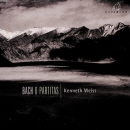|
|
Partitas BWV 825-830
Kenneth Weiss (Harpsichord)
Review: Partitas by Kenneth Weiss
|
K-3 |
Bach: 6 Partitas |

|
|
Partitas BWV 825-830 [20:52, 24:11, 22:21, 26:00, 14:24, 29:12] |
|
Kenneth Weiss (Harpsichord) |
|
Ambroisie |
Jun 1999 |
2-CD / TT: 137:20 |
|
Recorded at Église Evangélique Allemande, rue Blanche, Paris, France.
Buy this album at: Amazon.com | Amazon.com |
|
Kirk McElhearn wrote (October 8, 2001):
Bachs keyboard partitas were his first published works, his opus 1. These six suites were actually the last suites Bach wrote for keyboard, and owe a great deal to French influence. These are relatively popular works, and are recorded by most harpsichordists; in a way, they are the essential harpsichord works that all soloists must record.
Kenneth Weiss is an American harpsichordist living in France, where he has worked with William Christies Les Arts Florissants, among others. He also pursues a solo career. This is his first solo recording.
The first thing I noticed when listening to this recording is that the harpsichord has a big sound. It is an instrument by Anthony Sidey, and is after a German harpsichord from the Gottfried Silbermann workshop. This instrument has a rich sound at the lower end, and a bright sound at the treble end, making it almost sound like two different instruments playing together. The difference is especially noticeable in the majestic Allemande of the 4th partita, where the walking bass line provides a tonal contrast with the more discursive right-hand melody.
Weiss seems to be a bit unsure of himself in this recording. His playing can range from energetic and close to the text, as in the overture to the 4th partita, a rousing French overture that is one of the few such movements in Bach¹s oeuvre, to a more ornamented style in some of the slower movements, the allemandes and sarabandes. While the instrument sounds like two instruments, the performer at times sounds like two performers. He seems almost uncomfortable in some of the slow movements, as if they are too slow for his taste. To again mention the Allemande of the 4th sonata, which, for me, is the litmus test of any harpsichordist, he does not play the repeats, but plays the movement relatively slowly. Yet, at times, he seems to almost miss a beat, every now and then, as if he cannot follow the slow tempo very well. His playing is similar in the opening section of the Sinfonia of Partita no. 2. This movement begins with a series of chords and double notes played in a very complex rhythm. Weiss plays it exactly as the score shows, strictly, inflexibly, and it just sounds too rigid in his version.
He seems uncomfortable in the more complex rhythms of movements like the Praeludium to the 1st partita; he seems to want to play in a dotted rhythm, yet it is not clear whether this is actually the case. His phrasing seems confused, with slight hesitations every now and then that draw too much attention to themselves. The same is the case in the Menuet of this partita, where the rhythm seems uncertain, and one is not sure that it is truly a minuet.
Weiss seems right at home in the faster movements. The rousing Preambulum to partita no. 5 is a masterful display of virtuoso playing, and Weiss is brilliant. Movements such as the Gigue in the 1st partita are also brilliant; Weiss seems right in his element here, with its rapid arpeggios and runs.
To sum up, this is a mixed bag. Weiss is excellent in the faster movements and uncomfortable in the slower movements. But it is not enough to only play parts of the partitas well; Bach wrote a variety of movements to display the full range of dance movements common in the keyboard suite, and one needs to play them all well, or the performance sounds unbalanced, which is the case here. Kenneth Weiss seems to be a promising performer, but he just does not hit the mark in this recording. |
| |
|
Feedback to the Review |
|
Johan van Veen wrote (February 13, 2002):
[To Kirk McElhearn] It must have escaped my attention. Thanks anyway for posting it again. It seems that generally we have the same impression of this recording. I think "unbalanced" - your conclusion - describes my judgment pretty well. |
| |
|
|
|